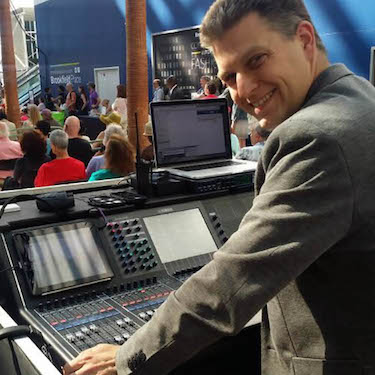|

SAFETY HARBOR, FLORIDA: Jody Elff is a multitalented audio professional with over 25 years of deep and diverse experiences in venues of almost every shape, size, and quality. He cut his teeth in the late 80s and early 90s in Boston, and then after moving back to the New York area, working front-of-house for leading-edge jazz acts like The New York Voices and Diana Krall. In the late 1990s, he earned a privileged spot with New York’s avant garde guru Laurie Anderson, serving as the lead engineer on her concert tours, the designer for her computer programs, and the recording and mix engineer for her acclaimed album, Laurie Anderson, Live At Town Hall, New York City, September 19-20, 2001. From there, he developed another long-lasting engagement with Bang On a Can, the visionary contemporary classical music organization that has revolutionized the relationship between popular and classical music. One thing leads to another, and Elff signed up to work front-of-house for Yo-Yo Ma and the Silk Road Ensemble. He later recorded the group’s Grammy nominated Off the Map and is currently in the midst of recording the group’s newest work. Other high-profile clients include Ethel, Tan Dun, Paul Winter, Hothouse Flowers, and Anderson’s late husband, Lou Reed.
All the while, Elff has nurtured a successful career as a fine artist by working in innovative ways with sound, and his diverse talents have earned him teaching opportunities at MIT, Rensselaer Polytechnic Institute, and Hartt School of Music. His sonic installations have been shown at PS122, Dance Theater Workshop, The Kitchen, and Moving Image Gallery, and he has a commissioned sound installation permanently installed in Lyon, France. He contributed sound design to The Blind, an immersive sonic experience at Lincoln Center in which blindfolded audience members experienced a combination of live sound and prerecorded twenty-channel surround sound effects. The list could go on. Elff has basically had several interesting things going on at any given time for 25 years!
Just as a veteran furniture craftsman amasses the finest tools to do the finest work, so too has Elff amassed a collection of favored technology, including Metric Halo SpectraFoo signal metering and analysis software. “Back in the late 1990s, when I started working with Laurie Anderson, I had my first opportunity to have complete design control over the PA system (rather than just being a guest at a venue for an evening), and I was well aware of how important proper PA alignment was to a successful show,” he said. “Back then, in many local venues, it was still the Wild West. I could walk into a venue with an artist and it could be great or it could be really terrible. Through my friends at Firehouse Productions, I was introduced to the guys who, at the time, were just starting Metric Halo. They gave me a run-through of SpectraFoo, and I immediately recognized its value for system analysis, and started using it on Laurie’s tours. I’ve been using it ever since.”
Although most of the venues Elff travels to in the United States with his current roster of clients, such as Yo-Yo Ma and the Silk Road Ensemble, are paragons of state-of-the-art sound reinforcement, many of the venues he travels to around the world are not. “There are still lots of venues around the world where the in-house staff has little or no idea how their system works (if it works at all!) and still others where technicians come in and hang some speakers and then leave entirely,” he said. “I use SpectraFoo to get a quick and accurate picture of what’s happening in the room so that I can make the most efficient changes for a good show.”
One thing Elff uses SpectraFoo for, even in the best venues in the world, is to accurately time-align the system to match the arrival time of the onstage percussion. “Most of the acts I’m working with require delicate careful sound reinforcement, rather than just amplification,” he said. “The Silk Road Ensemble is made up of instruments that don’t always sit well together acoustically. It is even sometimes difficult for the musicians to hear each other when they practice. That said, I’m not using the PA aggressively, and you can still hear energy from the instruments on stage. I use SpectraFoo’s delay finder to align the sound from the PA with the acoustic impulse from the percussion, and it’s remarkable to hear what a difference it makes. Without the time alignment, the PA is obvious and, to my mind, distracting. When I kick in the delay, it’s like the PA disappears and the focus returns to the stage, where it belongs. This is not a “new” technique – engineers have been doing this for decades – but it is still astonishing how radically it can improve the audience’s listening experience, especially in a primarily “acoustic” setting.” In venues with multi-zone systems, Elff uses SpectraFoo to separately time and phase align subwoofers, main arrays, balcony fills, front fills, and so on.
When he teaches, Elff uses SpectraFoo to give students a visual representation of sonic characteristics that are otherwise difficult to effectively talk about. “In addition to using SpectraFoo’s Spectragram when I’m getting a handle on, say, a museum space, it’s a great tool for teaching,” he said. “For most people who are not musicians or audio professionals, sound is a relatively abstract thing, and we lack a common vocabulary for talking about its different aspects. Often, the public at large can only say that something is ‘too loud,’ ‘too quiet,’ ‘doesn’t sound good,’ or ‘sounds great!’ But students who are getting serious about working with sound need much more than that. I’ve found that showing them a Spectragram is hugely revelatory for them. It’s a powerful first step in making the intangible tangible and from there you can begin to have a real dialog.” |